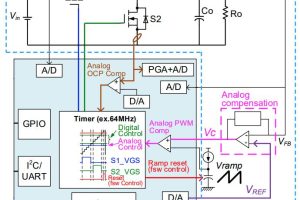“As Silicon Labs’ most energy-efficient SoCs to date, all three will enable IoT device makers to build wireless devices for battery-optimised and battery-free devices that can harvest energy from external sources in their environments like indoor or outdoor ambient light, ambient radio waves, and kinetic motion,” said the company.
Each has an Arm Cortex-M33 application processor, and a 2.4GHz radio with its own Cortex-M0+ processor.
Features include a 150μJ 8ms wake-up, and also wake-on-RF, GPIO-wake and real-time clock wake from the deepest (EM4) sleep mode.
The three family members are:
- EFR32BG22E for Bluetooth LE and Bluetooth Mesh with a 76.8MHz Cortex-M33, up to 512kbyte of flash and 32kbyte of ram. Some variants have Bluetooth 5 angle-of-arrival, angle-of-departure, sub-metre location and (125 and 500kbit/s) Long Range
- EFR32MG22E for Zigbee also gets a 76.8 MHz Cortex-M33
- EFR32FG22E for proprietary protocols has a half-speed (38.4MHz) Cortex-M33
Each is available with up to 512kbyte of flash and 32kbyte of ram and a 6dBm 2.4GHz transmitter.
Compared with the earlier (2019) xG22 family (without the ‘E’ suffix), the xG22E family has lost secure boot, the associated root-of-trust, and the secure loader (an earlier version of this article incorrectly stated that FG22E parts had those extra security features, as well as secure debug, which it does not have).
Regarding the changes between xG22 and xG22E devices, the company told Electronics Weekly: “By re-visiting platform performance from earlier energy harvest products, changes were made in OTP ROM and energy management platform to make sure external hardware is protected against current spikes during wake-ups and allows customers to use the platform for energy-based decision making during firmware development.”
Wake-on-RF
All of the models have a low-power wake-on-RF receiver (branded ‘RFsense’) which will wake the device from some sleep states when RF energy above a threshold is detected. To prevent inappropriate waking, wake-on-RF has a selective mode designed to respond to a 1kHz OOK Manchester-coded signal with 8bit of preamble and 32bit sync word. Information on xG22E parts is not yet available, but the 2019 xG22 parts (without the ‘E’ suffix) had two hysteric pairs of selectable trigger thresholds: -28 and -40dBm, or -19 and -26dBm.
Security comes from hardware crypto acceleration (AES128/256, SHA-1, SHA-2 (up to 256-bit), ECC (up to 256-bit), ECDSA and ECDH), a true random number generator (NIST SP800-90 and AIS-31 compliant) and Arm’s TrustZone.

Focussing on the FG22E (proprietary radio version), the company claims consumption of 3.6mA 1Mbit/s GFSK Rx, 3.9mA 250kbit/s O-QPSK DSSS Rx, 4.1mA dBm Tx, 8.2mA 6dBm Tx, 26μA/MHz active (38.4MHz EM0 mode), 1.2μA deep sleep (EM2, 8kbyte ram retention, RTC (32.768kHz RC oscillator) or 170nA EM4 ‘shut-off’.
For all the devices, operation is from a single 1.71 to 3.8V rail and over -40 to +85°C.
Packaging is 5 x 5mm QFN40 or 4 x 4mm QFN32.
Teaming up with harvesting IC company e-peas, SiLabs has developed two energy harvesting extension boards for the xG22E Explorer Kit, each tuned for different energy sources and energy storage. One uses e-peas AEM13920 dual-harvester for twin energy sources, the other is based on AEM00300 and collects power from random pulsed energy sources.
Find the FG22E data brief here (In an earlier version of this article, this link incorrectly went to the FG22 (not FG22E) product page.
 Electronics Weekly Electronics Design & Components Tech News
Electronics Weekly Electronics Design & Components Tech News



